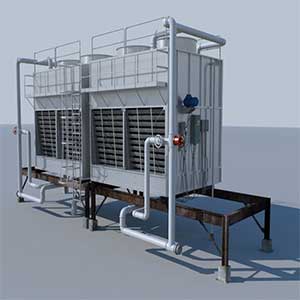Overview
Closed Circuit Hybrid Cooling Towers deliver fully rated thermal performance over a wide range of flow and temperature requirements. Distinct advantages of the Hybrid include plume abatement, significant water savings over traditional water-cooled equipment, and its suitability for high temperature cooling (>80 °C). First, the process fluid is circulated through the dry coil. A portion is of the heat is rejected to the air passing over the dry coil.
Principle of Operation
Closed Circuit Hybrid Cooling Towers operate in a manner similar to open cooling towers, except that the heat load to be rejected is transferred from the process fluid (the fluid being cooled) to the ambient air through a heat exchange coil. The coil serves to isolate the process fluid from the outside air, keeping it clean and contaminate free in a closed loop. This creates two separate fluid circuits: (1) an external circuit, in which spray water circulates over the coil and mixes with the outside air, and (2) an internal circuit, in which the process fluid circulates inside the coil. During operation, heat is transferred from the internal circuit, through the coil to the spray water, and then to the atmosphere as a portion of the water evaporates.

The process fluid then enters the wet coil where the remaining heat of the process fluid is transferred through the tube wall to the water cascading downward over the tubes. Simultaneously, air is drawing in through the air inlet louvers at the base of the cooler and travels upward over the coil opposite the spray water flow. A small portion of the water is evaporated which rejects heat. The warm moist air is drawn to the top of the closed circuit cooler by the fan and is discharged to the atmosphere. The remaining water falls to the sump at the bottom of the cooler where it is recirculate by the pump through the water distribution system and back down over the coils.
